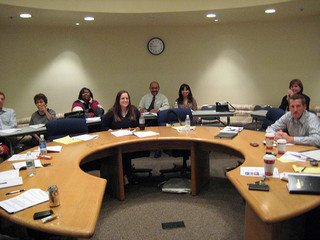Making Your Meetings More Efficient
 Previously, I’ve talked about what’s wrong with many meetings and ways to increase meeting participation. In the same vein, this blog will focus on seven meeting best practices. It’s a topic worth re-visiting, because while meetings are a crucial part of the work environment, a lot of them are run and planned quite poorly. These tips will help you get the most out of your meeting, the best from your team, and vice versa.
Previously, I’ve talked about what’s wrong with many meetings and ways to increase meeting participation. In the same vein, this blog will focus on seven meeting best practices. It’s a topic worth re-visiting, because while meetings are a crucial part of the work environment, a lot of them are run and planned quite poorly. These tips will help you get the most out of your meeting, the best from your team, and vice versa.
Hold Standing Meetings
To make time pass more quickly, some companies have adopted the standing meeting. These have helped workers not only work faster, but more creatively and collaboratively. It makes workers work faster because no one likes standing up for too much time. The format helps them focus on business, instead of daydreaming. Plus, a study conducted by researchers at Washington University found that standing meetings result in better collaboration and creativity.
Ban Laptops
Laptops are a temptation. While a worker may be listening to you speak, they could also be checking e-mail, scanning Facebook or browsing some other site at the same time. Enforce a “no laptop” rule if at all possible, and have workers take notes on pen and paper instead. Students who take notes by hand have been shown to retain certain types of information much better than their laptop-using peers.
Set a Timer
If you can’t enforce standing meetings, there’s another good technique for keeping the meeting short and on-point: Set a timer. Much like standing up for the entire meeting, having a time limit imposed on your meeting time can keep you focused and well-directed. This is a modified version of the Pomodoro technique, a productivity trick that has you set a timer, then get as much work done as possible before time runs up.
Give Clear Directions
By the time the meeting ends, each person involved should have a specific idea of what they’ll be doing over the next week. Deciding who would be responsible for what by the time the meeting ended was the M.O. of Steve Jobs. Tasks were assigned to D.R.I’s, or “directly responsible individuals.” This added a sense of clear direction and accountability to Apple’s meetings.
Avoid Scheduling Meetings Far in Advance
Don’t try to schedule meetings weeks before they need to take place. Workers get inundated with information on a daily basis. It’s highly likely that the things they need to remember for a meeting scheduled three weeks in advance will be forgotten by the day of the actual meeting. To make sure the important issues are top of mind, schedule your meetings carefully.
Give Praise Where It’s Due
While this tip won’t necessarily make your meetings more efficient, it will have the positive effect of boosting morale. Resentment can build when workers feel unappreciated. Let them know you’re grateful for their hard work by acknowledging how they’ve contributed to the team. Even praise for simple tasks can help them feel valued and important. Plus, compliments can make the meeting more enjoyable for your colleague—which is always a good goal to strive for.
Stop Talking
Want to really revamp your meetings? Try introducing two minutes of silence. That’s what Chief Happiness Officer blogger Alexander Kjerulf suggests for brainstorming solutions. “A well-placed two-minute silent break is a great chance for people to stop and think,” he writes. “To figure out what the deeper issues are. To see the solution that is not immediately obvious. To find out how they feel about the issues being discussed.”
He recommends presenting the facts of a problem first, then trying a two-minute silence so workers can ponder possible answers.
What advice would you add to this list?
photo credit: Phil Sexton via photopin cc



